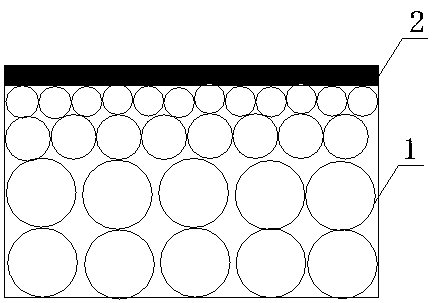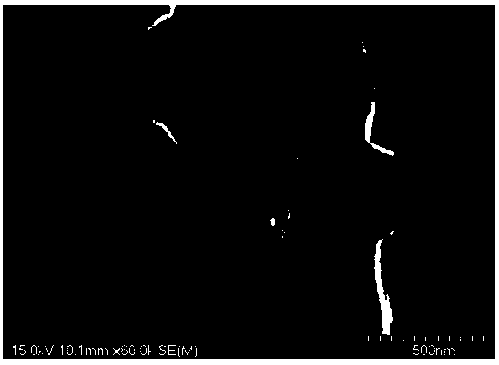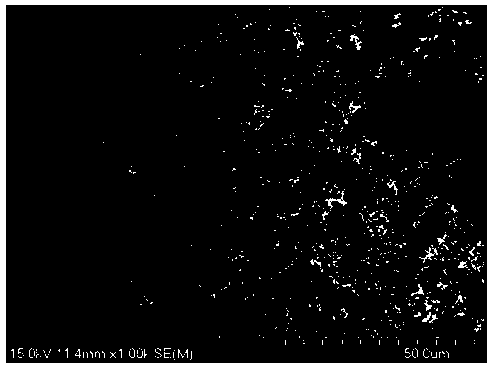Permanent hydrophilic polyvinylidene fluoride membrane and production method thereof
A technology of polyvinylidene fluoride membrane and manufacturing method, which is applied in the field of water treatment, can solve the problems of easy loss, limited selection space, and difficulty in industrialization, and achieve the effect of highly stable hydrophilicity, simple production process, and dense separation layer
- Summary
- Abstract
- Description
- Claims
- Application Information
AI Technical Summary
Problems solved by technology
Method used
Image
Examples
Embodiment 1
[0047] A permanently hydrophilic polyvinylidene fluoride membrane, comprising a microporous support layer 1 and a dense separation layer 2, the dense separation layer 2 is located on the outer surface of the microporous support layer 1, as attached image 3 Shown is the scanning electron microscope (SEM) image of the cross-section of the polyvinylidene fluoride membrane described in this embodiment magnified 1000 times. It can be seen that the microporous support layer 1 is a honeycomb-shaped opening with an average pore size of 1 µm. figure 2 Shown: SEM detection of the outer surface of the dense separation layer 2 under a magnification of 60,000 has no obvious pores.
[0048] A reinforced polyvinylidene fluoride hollow fiber composite membrane is made, with an outer diameter of 2000 μm, a membrane thickness of 200 μm, and a porosity of about 75%. The pure water flux of the membrane is 720 LMH / bar, and the compressive strength is 0.4 MPa. The bubble pressure in Porefil is ab...
Embodiment 2
[0058] Other parts are the same as in Example 1, the difference is:
[0059] Send the homogeneous solution after defoaming at 120°C in Example 1 to the forming scraper mold, and cast it together with the polypropylene non-woven fabric. After staying in the air at room temperature for 1 S, send it to the cooling medium at 60°C Internally solidified into a film, wherein the cooling medium is composed of 20% by weight PEG (200) and 80% by weight of water. After the film is formed, it is naturally dried at room temperature.
[0060] The resulting flat composite membrane has a thickness of 200 μm and a porosity of about 85%. Figure 4 As shown, the separation layer 2 of the membrane is the surface pores of 0.01-0.05 μm detected by SEM on the outer surface at a magnification of 30000, as shown in the attached Figure 5 As shown, the support layer 1 is a sponge-like, open-pore microporous support layer with an average pore diameter of about 2.5 μm. The pure water flux of the membra...
Embodiment 3
[0062] Other parts are the same as in Example 1, the difference is:
[0063] Stir the polymer and solvent together at 90°C to form a homogeneous solution, wherein the hydrophilic resin sulfonated polysulfone (SPSF, sulfonation degree ≈ 30%, [η] ≈ 0.6) weight percent is 2%, glycerin ( The weight percentage of GI) is 6%, the weight percentage of polyvinylidene fluoride PVDF (3F904) is 20%, and the weight percentage of dimethylacetamide DMAc in the solvent system is 72%.
[0064] In the case of maintaining the uniform distribution of the four strands of reinforcing fiber filaments, send the degassed homogeneous solution at 90°C to the forming hollow mold, and introduce internal filler water. After the composite solution stays in the air for 2 seconds, it enters the cooling at 50°C. The medium is solidified to form a film, and finally a reinforced polyvinylidene fluoride film with four strands of fibers evenly distributed in the hollow film is formed, and the cooling medium is com...
PUM
| Property | Measurement | Unit |
|---|---|---|
| pore size | aaaaa | aaaaa |
| pore size | aaaaa | aaaaa |
| water contact angle | aaaaa | aaaaa |
Abstract
Description
Claims
Application Information
 Login to view more
Login to view more - R&D Engineer
- R&D Manager
- IP Professional
- Industry Leading Data Capabilities
- Powerful AI technology
- Patent DNA Extraction
Browse by: Latest US Patents, China's latest patents, Technical Efficacy Thesaurus, Application Domain, Technology Topic.
© 2024 PatSnap. All rights reserved.Legal|Privacy policy|Modern Slavery Act Transparency Statement|Sitemap



